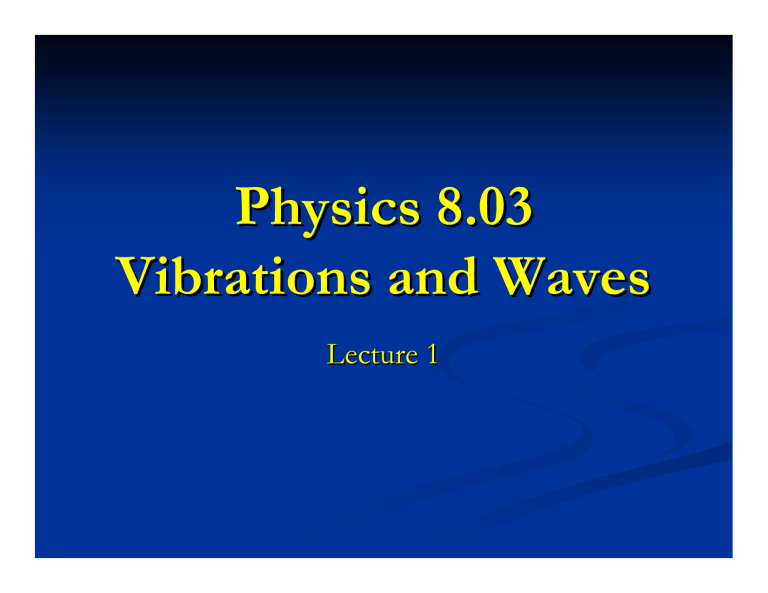Physics 8.03 Vibrations and Waves Lecture 1
advertisement

Physics 8.03 Vibrations and Waves Lecture 1 Organizational things Staff Nergis Mavalvala (L) Alexander van Oudenaarden (R) Matt Borthwick (R) Chris Kouvaris (tutor) Grades 10 problem sets = 25% total 3 in-class exams = 15% each Exam reviews will be held, look at web site for details 1 final exam = 30% Posted on Sundays, due at 4pm Fridays During finals week Take-home experiments (incomplete) Outline of course Mechanical oscillators (and some electrical circuit analogs) Mechanical waves Electromagnetic waves Optical phenomena Why oscillations and waves? And all semester long? Because oscillations in nature are ubiquitous (and we know how to solve the eqn. of motion) Periodic motion + circular orbits Optical, electrical and mechanical structures + resonance Because waves pervade the universe Mechanical waves (sound, water, phonons…) Electromagnetic waves (radiation, visible light…) Matter waves (atoms, BECs, QM) Gravitational waves (neutron stars, black holes, GR) Phasing in music Steve Reich: “Violin Phase” (1967) A repeated segment of music is played simultaneously by three violins at slightly different tempos (phases) Musically gifted folks will notice that the violins come in and out of phase periodically He discovered this when he was trying to play back an identical music piece with two tape recorders that ran at slightly different speeds (?) Formation of a BEC When a gas of atoms is cooled to absolute zero, the atoms congregate in the ground state The wave functions of the particles overlap and their phases get locked to each other All the atoms are in a single quantum state and form a strong matter wave The laser power changes the shape of the potential in which the atoms are trapped Gravitational waves from a pair of black holes Two black holes coalesce The emerging GWs carry signature of the quasinormal oscillation mode of the final black hole OPTICS Multiple Sources Interference Diffraction HARMONIC OSCILLATORS Free or Damped Driven Î RESONANCE Exam 1 Final Exam Exam 3 Exam 2 COUPLED OSCILLATORS N = few Î NORMAL MODES N = many (continuous media) Î MECHANICAL WAVES wave equation… ELECTROMAGNETISM EM WAVES in vacuum EM sources Î RADIATION EM waves in media (conductors + dielectrics) Today: SIMPLE HARMONIC MOTION Announcements Equation of motion for SHM Solutions to equation of motion Harmonic functions Complex numbers (Periodic functions) Energy in oscillators Conservative forces, quadratic potentials and SHM Approximate SHOs: the pendulum




